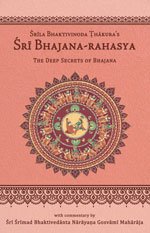Bhajana-Rahasya
by Srila Bhaktivinoda Thakura Mahasaya | 2010 | 123,965 words
The Bhajana-rahasya Text 32, English translation, including commentary (vritti). The Bhajana-rahasya is a compilation of verses describing the mercy of the eight pairs of names (Yugala-nama) of the Maha-mantra. This is text 32 belonging to the chapter “Prathama-yama-sadhana (Nishanta-bhajana–shraddha)” representing the last six dandas of the night: approximately 3.30 a.m.–6.00 a.m.
Text 32
Hari-bhakti-vilāsa (17.112, 99 last line, 123, 124, 126 last line) gives the following injunctions for chanting:
तुलसी-काष्ठ-घटितैर् मणिभिर् जप-मालिका
सर्व-कर्माणि सर्वेषाम् ईप्सितार्थ-फल-प्रदा
गो-पुच्छ-सदृशी कार्या यद् वा सर्पाकृतिः शुभा
तर्जन्या न स्पृशेत् सूत्रं कम्पयेन् न विधूनयेत्
अङ्गुष्ठ-पर्व-मध्यस्थं परिवर्तं समाचरेत्
न स्पृशेत् वाम-हस्तेन कर-भ्रष्टां न कारयेत्
भुक्तौ मुक्तौ तथा कृष्टौ मध्य-मायां जपेत् सुधीःtulasī-kāṣṭha-ghaṭitair maṇibhir japa-mālikā
sarva-karmāṇi sarveṣām īpsitārtha-phala-pradā
go-puccha-sadṛśī kāryā yad vā sarpākṛtiḥ śubhā
tarjanyā na spṛśet sūtraṃ kampayen na vidhūnayet
aṅguṣṭha-parva-madhyasthaṃ parivartaṃ samācaret
na spṛśet vāma-hastena kara-bhraṣṭāṃ na kārayet
bhuktau muktau tathā kṛṣṭau madhya-māyāṃ japet sudhīḥA japa-mālā made of tulasī or precious stones fulfils all kinds of inner desires. A japa-mālā shaped like a cow’s tail or a snake is auspicious. One should not touch the japa-mālā with the forefinger. One should not swing or shake the mālā again and again while chanting. Chant and change the direction of the mālā using the thumb and the middle finger. Do not touch the mālā with the left hand, and do not let it fall from the hand. Those who desire material enjoyment (bhukti) and those who desire liberation (mukti) chant with the middle finger.
Commentary: Bhajana-rahasya-vṛtti:
Although it is mentioned that one can use a japa-mālā of precious stones, such a mālā is not used in our sampradāya. Also, it is mentioned that chanting with the middle finger is for those desiring sense enjoyment and liberation. Nonetheless, we chant in this way because we follow the method adopted by our guru-paramparā.
